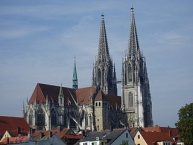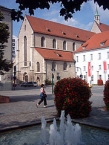Cycle Tour Regen - Ilz - Danube - Isar - Danube
Travel report
Actions
![]()
Please wait - map data are loading
Added on 31 Jan 2020,
on 18 Aug 2020
Actions
Cycle route metrics
planned
ridden
Total distance in km
504
533
Cumulative elevation gain in m
5.053
3.800
Avg. slope uphill in %
1,00
0,71
Cumulative elevation loss in m
5.056
3.798
Total cycling hours
-
32,9
Avg. pace in km/h
-
16,2
Information about rights to the gps-track data | |
|---|---|
Rights owner | ThimbleU & biroto-Contributors |
Rights characteristic / license | cc0: Public Domain no Rights reserved |
Link to the description of the license | |
GPX file taken from | |
GPX file uploaded | by ThimbleU on 31 Jul 2020
|
Track points in total
8.445
9.000
Track points per km (avg)
17
17
Start/endpoint
Start location
Regensburg, Bayern, DE (342 m NHN)
End location
Regensburg, Bayern, DE (340 m NHN)
Stages
Beds4Cyclists, worth visiting and infrastructure
Name and address
Latitude / Longitude
Phone
Fax
Mobile
Type of accommodation
Rating for cyclists
Route km
Dist. to route
Elevation
0 km
0,2 km
346 m
1 km
0,5 km
345 m
- Beratung von Touristen und Einheimischen
- Zentrale Zimmervermittlung für Regensburg und das Umland
- Kartenvorverkauf von Tickets für (Konzert& Theater-)Veranstaltungen in Regensburg und in der Umgebung
- Verkauf von Tickets für Stadtführungen, Stadtrundfahrten, Schifffahrten und Tagesausflüge
- Verkauf von Eintrittskarten für das Reichstagsmuseum
- Ausleihe von Audioguides für selbstständige Stadtführungen
- Verkauf von Busfahrkarten für den Regensburger Personennahverkehr
- Kostenloser Prospektversand
- Verkauf von Souvenirs
Information about copyright | |
|---|---|
Rights characteristic / license | by-sa: CREATIVE COMMONS Attribution-ShareAlike |
Link to the description of the license | |
taken over / edited on | 16 Nov 2014
|
taken over / edited by |
|
Hours of opening
Mo.- Fr. von 9.00 Uhr - 18.00 Uhr
Samstag von 9.00 Uhr - 16.00 Uhr
So. + Fei. 01.04.-31.10. von 9.30 Uhr - 16.00 Uhr
So. + Fei. 01.11.-31.03. von 09.30 Uhr - 14.30 Uhr
Samstage im Advent von 9.00 Uhr - 18.00 Uhr
Faschingsdienstag von 9.00 Uhr - 14.30 Uhr
1 km
0,4 km
344 m
1 km
0,5 km
342 m


Regensburg is one of Germany's oldest towns, founded by the Romans in 179 AD. It's in the German federal state of Bavaria, at the northernmost point of the river Danube. Acting as capital of the district of Upper Palatinate and also its biggest settlement, Regensburg today is a thriving city of about 137,000 inhabitants, two universities and many landmarks and little chapels, most dating back to the Middle Ages (e.g. the Cathedral of St. Peter, the Old City Hall and Imperial Diet, and the Stone Bridge). According to legend there are so many chapels here, that there would always be at least one church bell ringing. Since 13.07.2006 the historic city center of Regensburg and Stadtamhof has been a UNESCO World Heritage site. Because of its narrow alleys Regensburg is often called the northernmost city of Italy.
History
Although the earliest settlements date back as far as 5000 BC and it is evident, that the first Celtic settlement, called Ratisbona, was in the city's present-day vicinity since the first millenium BC, the official history starts in 179 AD, when the Romans built the fortress Castra Regina at the northernmost bend of the river Danube. For the following 200 years the fortress served as the Romans main military base in the province of Raetia. After the Romans left the area during the Barbarian Invasions, the town became a civil settlement. Being granted one of the first seats of a bishopric on German territory in 739, Regensburg grew to strength and prosperity during the Middle Ages. After the completion of the Stone Bridge (Steinerne Brücke) in 1146, a symbol of the town's importance in trade, that reached as far as Paris, Venice or Novgorod, the constructions of the cathedral started in 1273. The builders needed nearly 600 years until 1872 to complete this task. Both the Stone Bridge and the Regenburg Cathedral survived unchanged and are the city's main sights today. Having been one of the largest and most important German cities during the Middle Ages, Regensburg became a Free Imperial City (Freie Reichsstadt) in 1245 and was seat to the Perpetual Diet (Immerwährender Reichstag) of the Holy Roman Empire from 1663 to 1806, when the Empire dissolved during the Napoleonic Wars. Napoleon forced Regensburg to agree to become a part of the Kingdom of Bavaria in 1810, which set an end to the city's political importance. However, Regensburg economically regained strength because of its role as a river port for crude oil imports from Eastern Europe. Although Regensburg was target to 20 allied bombings during World War II, because it was home to one of Messerschmitt's main aircraft factories as well as an oil refinery, the historic city center took only little damage. There were two sub-camps of the Flossenbürg concentration camp located in the vicinity of the town for a brief period of time in early 1945. After World War II Regensburg slowly recovered. In 1960 the university was founded and several large companies like Siemens, BMW, Infineon, and Toshiba built factories in the city. In 2006 Regensburg's historic city center was appointed a UNESCO World Heritage Site.
See
The main attraction of Regensburg is its excellently preserved medieval city centre, with Regensburg Cathedral and the Stone Bridge being the highlights. As one of the few cities in Germany mostly undamaged during World War II, Regensburg boasts the largest preserved medieval city centre in Germany. It is sometimes called "the northernmost city of Italy" due to the lively places and streets with lovely outdoor cafes during summer, as well as the large number of Italian-style medieval merchant houses and towers. The historic centre lies next to the river Danube (German: Donau), and crossing the medieval stone bridge into the town provides a perfect entrance to the city and a great view over the whole historic city centre.
Churches
Regensburg has got a lot of churches, chapels and former monasteries. According to legend there are so many of them, that there would always be at least one of them ringing.
- ⊙Minor basilica Unserer lieben Frau zur Alten Kapelle, Schwarze-Bären-Straße 7, ☎ +49 941 57973. The church was first mentioned in 875. It was renovated several times and nowadays the interior is a great example of Rococo architecture. Especially the altar is of outstanding beauty.
- ⊙Neupfarrkirche, Neupfarrplatz 5, ☎ +49 941 5920112. Neupfarrkirche is a Protestant church at the central square of Regensburg. The first structures were built in 1519, shortly after the Jewish population, who lived in the neighbourhood, was illegally chased out of the city during a power vacuum caused by the death of emperor Maximilian I.
- ⊙Regensburg Cathedral (Regensburger Dom), Domplatz 1, ☎ +49 941 5971660. Apr-May & Oct 06:30-18:00, Jun-Sep 06:30-19:00, Nov-Mar 06:30-17:00. The Cathedral of St. Peter is the seat of the Catholic diocese of Regensburg and the prime example of Gothic architecture in Bavaria. Construction commenced in 1273 and the church was finished in 1872, after more than 600 years of work. The cathedral is open for visitors outside mass. Tours are available for individuals as well as groups. A highlight is a concert or rehearsal of the world famous boys' choir Domspatzen. free.
- ⊙Scots Monastery (Jakobskirche), Jakobstraße 3, ☎ +49 941 29830. Daily 08:00-18:00. Founded around the year 1070 by Hiberno-Scottish missionaries, the church was in the hands of Irish and Scottish monks most of its history. The most famous architectural element of the structure is the dark north portal with its enigmatic composition of ornamental and figural sculptures. Contrary to the dark outside, the interior is very bright and friendly. free.
Buildings
- ⊙Historic Sausage Kitchen (Alte Wurschkuchl), Thundorferstraße 3, ☎ +49 941 466210. Daily 08:00-19:00. This tavern by the Danube was the first sausage kitchen in the world and already served the construction workers of the Stone Bridge and the Cathedral in the 12th century. That allegedly makes it the first fast food joint ever. It is still a restaurant specializing in all kinds of sausage dishes and a definite must-see for every Regensburg visitor.
- ⊙Palace St. Emmeram (Schloss St. Emmeram), Emmeramsplatz 5, ☎ +49 941 50480. Tours: Daily 10:30, 12:30, 14:30, 16:30. St. Emmeram is a palace of the Princely House of Thurn and Taxis, a former key player in postal services in Europe. The palace can only be visited as part of a tour, as the owners still live here. The treasure chamber and royal stables can be visited daily 11:00-17:00 for €4.50 without booking a tour. Adults €13.50, Concessions €11.
- ⊙Porta Praetoria, Unter den Schwibbögen. The Porta Praetoria is claimed as Germany's most ancient stone building. It is dating back to 179 AD and was the northern gateway of the Roman settlement and military camp Castra Regina.
- ⊙Stone Bridge (Steinerne Brücke), Steinerne Brücke. The Stone Bridge is Regensburg's most important landmark, besides Regensburg Cathedral, and a masterpiece of medieval architecture. It was built 1135-1146 and today is a pedestrian bridge that connects the city center with Stadtamhof.
Museums and Monuments
- ⊙Old Town Hall and Museum of the Imperial Perpetual Diet (Reichstagsmuseum), Rathausplatz 1, ☎ +49 941 5073440. Tours: Nov-Dec & Mar 14:00, Apr-Oct 15:00. Regensburg was the seat of the Perpetual Diet of the Holy Roman Empire 1663-1806. The museum, which is located in the Old Town Hall, focuses around the Holy Roman Empire and its influence on German and European history. €40 + (per person) €4.
Information about copyright | |
|---|---|
Rights characteristic / license | by-sa: CREATIVE COMMONS Attribution-ShareAlike |
Link to the description of the license | |
Input taken over from: |
Wikivoyage contributors, 'Regensburg', Wikivoyage, The FREE worldwide travel guide that anyone can edit, 3 July 2016, 18:40 UTC, <https://en.wikivoyage.org/w/index.php?title=Regensburg&oldid=3018362> [accessed 27 September 2016] |
taken over / edited on | 27 Sep 2016
|
taken over / edited by |
|
1 km
0,6 km
331 m
![]()







